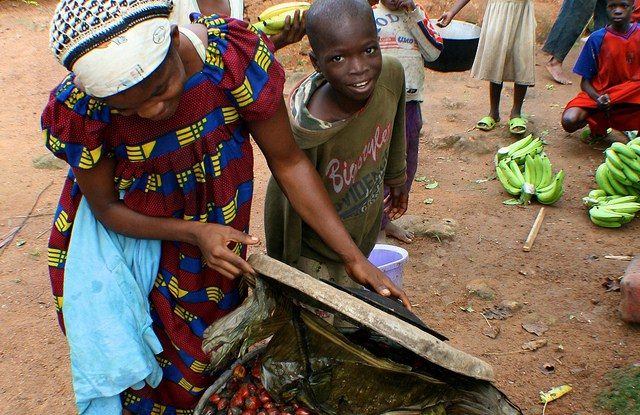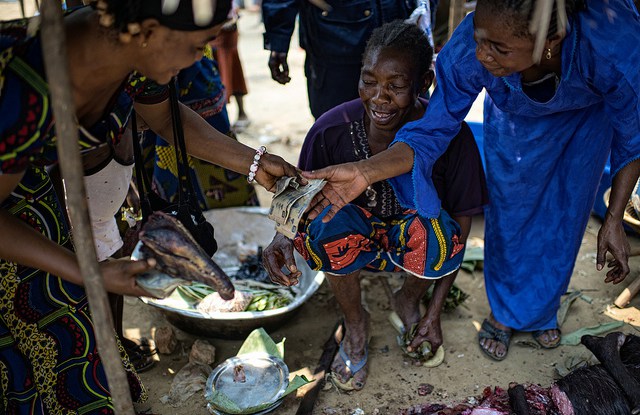
BOGOR, Indonesia — Meat. Woodfuel. Spices. Forests provide all these and more, yet the role of these products on rural livelihoods is still coming into focus.
A comparative study on the relative role of these non-timber forest products (NTFPs) in supporting livelihoods in three West African countries has reaffirmed the benefits of seeing forests in a wider context.
The study examined the relative importance of forest-related income for some 1,000 rural households in Cameroon, Nigeria and Ghana that have varying access to markets and forests. It also aimed to uncover regional patterns in a larger ecological, social and political context. In so doing, researchers highlighted the different roles that NTFPs play, or might play, in a landscape context.
Forests, as well as trees on farms, provide a myriad of ecosystem services, including wild foods and spices, materials for handicrafts, woodfuel and medicine, as well as shade, shelter and soil retention. The Poverty and Environment Network (PEN) global study recently reported that forest and other environment-related income generates up to 20 percent of household income.
“NTFPs make an important contribution to rural livelihoods, but they remain primarily the domain of the poor in remote areas,” said Terry Sunderland, a principal scientist with the Center for International Forestry Research (CIFOR) and co-author of the paper, which appears in a recent issue of the International Forestry Review.
NTFP activities are ideally suited for poor households because they are generally low-risk, requiring little capital investment or particular skills — so for poor NTFP harvesters, who often cannot access credit, forests can help diversify livelihoods and increase household resilience. The study’s principal author, Ruth Malleson, an honorary research fellow in the anthropology department of University College London and consultant at Triple Line Consulting, had previously noted that NTFPs provide women in remote settlements of Nigeria and Cameroon with a rare means of accumulating money for contingencies. Similarly, older children and women will harvest NTFPs such as bush mango during school holidays in the rainy season to earn money to pay school fees.
“NTFPs are most useful during the rainy season or periods of agricultural scarcity before and after the harvest,” Sunderland said. “Forests provide a safety net in terms of maintaining nutrition and diet, as well as against the shock of economic, environmental and climate events.”
In all three countries, researchers found that households headed by migrants were generally the poorest. In border areas of Ghana, as well as in the more accessible border and on-road zones of Cameroon and Nigeria, wealthier households plant perennial commercial crops such as cocoa, oil palm, plantain and banana. Poorer, predominantly migrant farmers generated most of their income from short-rotation and annual crops, such as cassava.
People who put all their money into cash crops like cocoa are extremely vulnerable to market changes outside of their control
Migrants in Cameroon and Nigeria are generally not allowed to plant perennial cash crops on their leased land; in Ghana, migrants tended to have relatively stable long-term leasing arrangements. Researchers noted that relatively poor, migrant households in remote settlements in Ghana relied on NTFP income while waiting for newly established cocoa plantations to become productive.
Poorer households, particularly those headed by women, need to be efficient with their time, as they have less available labor. Cassava is particularly attractive because it requires relatively little labor, can be planted throughout the rainy season and harvested over a two-year period. However, annual crops take a greater toll on the environment.
“Because they can only rent land, migrant farmers tend to plant cassava or annual crops that generate a quick return, but this encourages deforestation as many of these crops are light-demanding and need the trees removed to grow,” said Sunderland.
The researchers believe that NTFP income could well play an even more important role for remote rural households in West/Central Africa in the coming years.
“The safety net function will become more significant,” Sunderland said. “Not just because of climate change, but also due to economic shocks. People who put all their money into cash crops like cocoa are extremely vulnerable to market changes outside of their control.”
Citing CIFOR’s recent study on dietary quality and tree cover in Africa, Sunderland also suggested forest foods contribute significantly to dietary diversity and nutrition for poor households.
“It’s interesting that relatively poor families have comparatively good diets because of the diverse products available close to forests and trees in the wider landscape,” he said. Richer families outside the forest may have narrower diets, but have the means to purchase other products.
“NTFPs must be seen in a larger context,” Sunderland said. Integrated landscape approaches at a regional level, he said, go well beyond managing resource conflicts and promoting ecological sustainability.
For more information about the issues in this article, contact Terry Sunderland, t.sunderland@cgiar.org.
Fieldwork for this study was funded by the former Forestry Research Programme of the UK’s Department for International Development (DFID). This research also forms part of the CGIAR Research Program on Forests, Trees and Agroforestry.
We want you to share Forests News content, which is licensed under Creative Commons Attribution-NonCommercial-ShareAlike 4.0 International (CC BY-NC-SA 4.0). This means you are free to redistribute our material for non-commercial purposes. All we ask is that you give Forests News appropriate credit and link to the original Forests News content, indicate if changes were made, and distribute your contributions under the same Creative Commons license. You must notify Forests News if you repost, reprint or reuse our materials by contacting forestsnews@cifor-icraf.org.

